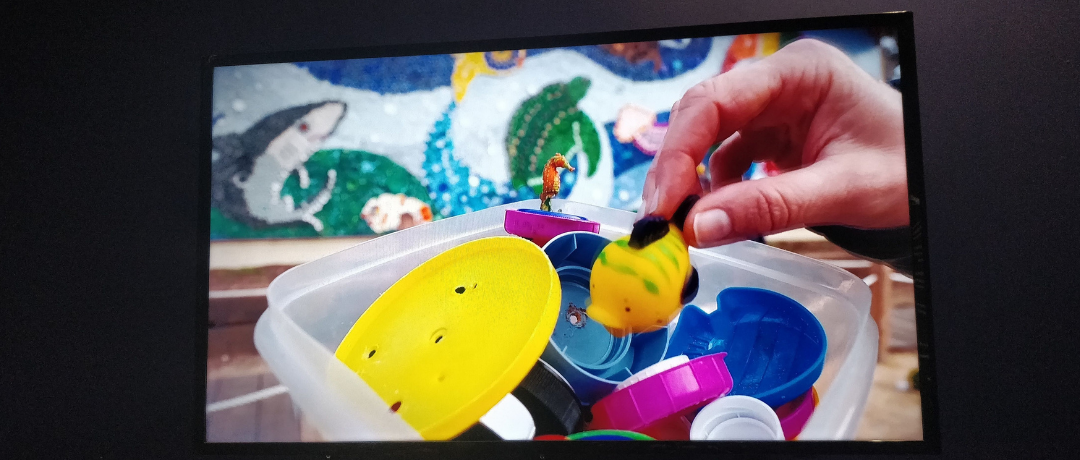My first experience of climate action and conversation in a cultural exhibition space was at the Eden Project in Cornwall, at an exhibit with a small glass box, displaying a tiny plastic seahorse. This seahorse, the exhibition told me, had been fitted with a tracker, and then discarded. On its own, it travelled across the world – carried on ocean currents along with millions of other pieces of discarded and non-reusable plastic. This seahorse had then been picked up by a research team in the Arctic sea, eventually finding its way back to Cornwall, to the Eden Project exhibit where I was standing. This global journey of this tiny object (pictured above) has stayed with me across the years, an anecdote I offer in conversations about the future of the planet, and a memory that comes back to me each time I throw a piece of plastic into the bin. This retention of memory demonstrates, to me, the power of culture – and cultural institutions – when they choose to represent the ecological and climate crisis that we are living amidst.
If we acknowledge that the climate emergency is a global problem that sits at an intersection affecting every sector, (or every part of our world), the arts, culture, and heritage sectors are no different. However, the UNESCO guidelines on culture and climate change focus on mitigation and adaptation, resilience and on refuge, rather than culture as a site of action or regeneration. We at ReReeti believe that cultural institutions – in our case, museums – can play an active and meaningful role in engaging with the climate emergency as they do with culture, the arts, or heritage and history. Through conversation, engagement, learning and intersectionality, museums can begin to hold space for this aspect of our past, present, and future. Then, a museum’s biggest resource, its audience, can also become a tool for change and for promoting regenerative practices.
So what are some of the ways that museums can do this? By engaging with their collections, becoming advocacy organisations when partnering with others, considering the origins of funding sources, mitigating their own carbon footprint and creating best practices for exhibit design and institutional planning. Perhaps we can consider these three starting points:
- Using Museum Collections, Spaces & Exhibits to tell stories of Climate & Ecological Crisis
As Culture Declares Emergency argues, museums are unique in that they allow the mapping of time – of the past, present and future. The climate emergency is not a new problem, but one that has grown with the increasing human population, the strain on the earth’s boundaries, a reliance on non-renewable resources and a system relying on constant economic growth. Objects in museums seen through this lens can connect us to the world we had before, the world we live in now, and help us to imagine the world we want to live in, in the future.
- Creating a Framework for Institutional Best Practices regarding the use of Resources
Choosing to invest in renewable energy, eradicating single-use plastics from museum sites, sourcing food and beverages from local producers and using sustainably sourced materials to build exhibits are all actions that museums can take to reduce their footprint. Speaking about these decisions, incorporating this into museum design, will in turn educate audiences and visitors about institutional choices and the reasons for them.
- Being selective about Funders and Corporate Partners
Perhaps one of the most challenging ways in which museums can begin to support the fight for a more sustainable future is by acknowledging that funding streams matter. Choosing to only accept funding from, and partner with, large organisations that are doing meaningful work to mitigate their impact on the environment would be a first step in ensuring that cultural institutions are doing all they can to acknowledge the climate emergency and its larger economic origins and implications.
Undoubtedly, there are more and myriad ways in which the culture, arts and heritage sector can have an impact on the Climate Emergency – Culture Declares Emergency has an 8-point framework for museums, available to view here. But as the tiny plastic seahorse, and its journey I narrated at the beginning of this blog post demonstrates, stories about objects, their origins, journeys, and impact on the climate & ecological emergency have enormous power to stay with our audiences. And it is these audiences and their takeaways from cultural spaces and institutions like museums, where real change can begin.
ReReeti Foundation has recently launched IMACC, India’s first museum network to tackle the climate emergency, in partnership with seven Indian museums (Museum of Christian Art Goa, Museum of Art & Photography Bangalore, Indian Music Experience Museum Bangalore, Kiran Nadar Museum of Art Delhi, DakshinaChitra Craft Museum Chennai, Kerala Museum & Arna Jharna) and Culture Declares Emergency, UK. The network aims to begin a nationwide conversation around these topics, providing resources, ideas, and a common platform for museums to begin to tackle the climate & ecological crisis.
To find out more about how ReReeti can help your institution become involved in these issues, email tejshvi@rereeti.org.
About the Author
Tiggy Allen is ReReeti’s Operations Manager, an avid reader and museum goer. She has written for Sahapedia, and been published in Scroll.in, South Asia Monitor and Live Mint Lounge documenting lesser known aspects of India’s history.









Recent Comments